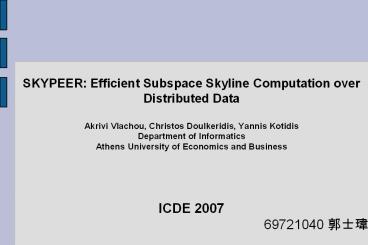SKYPEER: Efficient Subspace Skyline Computation over Distributed Data - PowerPoint PPT Presentation
1 / 17
Title:
SKYPEER: Efficient Subspace Skyline Computation over Distributed Data
Description:
SKYPEER: Efficient Subspace Skyline Computation over Distributed Data ... The skyline query is used to find a set of non dominated data points in a multi ... – PowerPoint PPT presentation
Number of Views:124
Avg rating:3.0/5.0
Title: SKYPEER: Efficient Subspace Skyline Computation over Distributed Data
1
- SKYPEER Efficient Subspace Skyline Computation
over Distributed Data - Akrivi Vlachou, Christos Doulkeridis, Yannis
Kotidis - Department of Informatics
- Athens University of Economics and Business
- ICDE 2007
- 69721040 ???
2
Outline
- Introduction
- Skyline Computation in P2P Networks
- SKYPEER Algorithm
- Experimental Evaluation
- Conclusion
3
Introduction
- The skyline query is used to find a set of non
dominated data points in a multi-dimensional
dataset, and most previous work has assumed a
centralized setting - The past assumption are hardly applicable to
large-scale P2P systems. - Relying on a super-peer architecture we propose a
threshold based algorithm, called SKYPEER and its
variants - For efficient subspace skyline processing, we
extend the notion of domination by defining the
extended skyline set - Skyline queries help users make intelligent
decisions over complex data
4
Skyline Computation in P2P Networks
- In general, super-peers maintain information
about the peers they have been assigned, so that
at query time, they can process a query without
having to contact all peers. - In this work we assume that the super-peer
topology is predefined and we focus on the
optimization of interactions among super-peers
and peers. - Preliminaries and Definitions
- Querying peer Pinit, henceforth referred to as
initiator of a query - All peers send their local datasets to Pinit
where a centralized skyline algorithm is executed
5
Skyline Computation in P2P Networks
6
Skyline Computation in P2P Networks
- Locally evaluate as many parts of the query as
possible. - Each super-peer needs to collect from the
associated peers only the skyline points of all
subspaces. - Given the locally stored extended skyline, each
super peer individually processes a subspace
skyline request and transmits the results to the
query initiator. - This approach is considered as baseline, and will
be henceforth referred to as naive.
7
(No Transcript)
8
Skyline Computation in P2P Networks
- Extended Skyline
- we adjust the dominance definition to compute all
necessary values co-instantaneously during the
skyline calculation. - Definition 1.
- For any dimension set U, where U ? D, p
ext-dominates q if on each dimension di ? U, pi
ltqi. The ext-skyline (ext-SKYU) is set of all
points that are not ext-dominated by any other.
9
Skyline Computation in P2P Networks
10
SKYPEER Algorithm
- Mapping
- each d-dimensional point p is transformed to a
one dimensional value f(p) based on the formula - Observation 5.
- Let psky be a skyline point in a subspace U.A
point p for which the following inequality holds
cannot be a skyline point in subspace U.
11
SKYPEER Algorithm
12
SKYPEER Algorithm
- Merging
- Each peer executes a local subspace skyline
computation - The initiator peer computes the overall subspace
skyline result by merging the local results
fig2
13
SKYPEER Algorithm
- Optimization
- 1. Threshold propagation
- (i) Fixed Threshold
- Pinit calculates its threshold t for q(U, t)
and forwards the threshold value to all
super-peers. - (ii) Refined Threshold
- Pinit calculates and sends its threshold to
its neighboring super-peers, which do not
forward it immediately to other super-peers, but
rather they first compute the subspace
skyline, calculate the new threshold t, and then
forward q(U, t).
fig1
fig2
14
SKYPEER Algorithm
- 2. Merging strategy
- (i) Fixed Merging
- All super-peers forward their computed
subspace skyline back to Pinit, and Pinit is
responsible for merging the results and computing
the resulting subspace skyline for q(U). - (ii) Progressive Merging
- Each super-peer merges the results it receives
with its locally computed subspace skyline,
before sending the results back to the
super-peer from which it originally received
the query.
fig1
fig2
15
Experimental Evaluation
16
Experimental Evaluation
17
Conclusion
- 4 variants are more efficient than naive
- Subspace?































